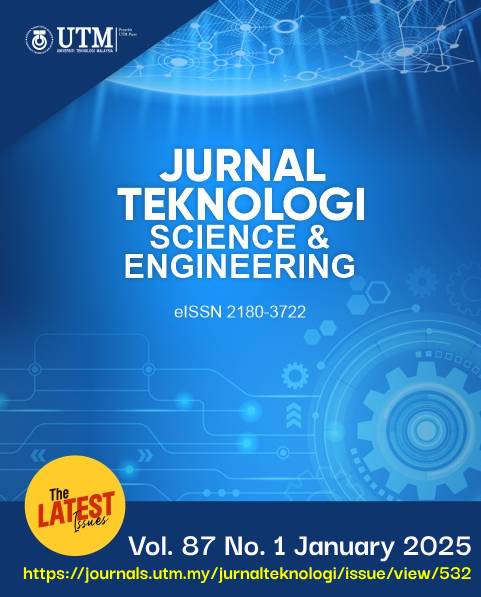INTERCONNECTION LINK ADDITIONS TOWARDS COMMUNICATION NETWORK CONSOLIDATION
DOI:
https://doi.org/10.11113/jurnalteknologi.v87.22309Keywords:
Communication networks, random topology, network collaborationAbstract
The ever-increasing demand for modern communication services and the rising cost of capital and operating expenditures have led to interest in multi-operator network collaborations. These network operators manage different network domains and infrastructures, such that their topologies may be disjointed from each other, and require the addition of intermediate interconnection links for the domains to communicate with each other. The main contribution of this paper is the proposal of an integer linear program for finding the optimum set of interconnection links to be added to the multi-domain networks such that the multi-domain networks become a connected graph, while minimizing either (1) the total length of added interconnection links, (2) the total shortest path length between all the border nodes of the multi-domain networks, or (3) the total number of shortest hop counts between all the border nodes of the multi-domain networks. The proposed integer linear program is shown to find the optimum solution under various properties for the multi-domain networks, albeit with increased computation time as the size of the problem increases. Simulation results using randomly generated multi-domain networks show a trade-off in terms of length of added links, shortest path length and shortest path hop count for each specific objective function.
References
Foros, Ø., Hansen, B. and Vergé, T., 2023. Co-operative Investment by Downstream Rivals: Network Sharing in Telecom Markets. Journal of Regulatory Economics. 64(1): 34-47.
Doi: https://doi.org/10.1007/s11149-023-09462-1.
Ashraf, M.W., Idrus, S.M., Aslam, R. and Iqbal, F. 2019. Capacity-bounded Lightpath Routing in WDM Optical Networks. Optical Fiber Technology. 48: 50-57.
DOI: https://doi.org/10.1016/j.yofte.2018.12.021.
Houngbonon, G. V., Ivaldi, M., Palikot, E. and Strusani, D., 2023. The Impact of Shared Telecom Infrastructure on Digital Connectivity and Inclusion. Toulouse School of Economics.
Doi: https://doi.org/10.2139/ssrn.4530998
Wibisono, G. and Fistarini, R. 2020, April. Design Analysis of Consolidation of Cellular Operators in Indonesia. Journal of Physics: Conference Series. 1528(1): 012035.
Doi: https://doi.org/10.1088/1742-6596/1528/1/012035.
Iqbal, F., van der Ham, J. and Kuipers, F. 2015. Technology-aware Multi-domain Multi-layer Routing. Computer Communications. 62: 85-96.
Doi: https://doi.org/10.1016/j.comcom.2015.01.010.
Leung, R. H. M., Xie, Z. and Chen, L. K. 2009. Optimization of Operational Fiber Links and Interconnections for the Merger of Two Networks. Optical Fiber Technology. 15(1): 57-64.
Doi: https://doi.org/10.1016/j.yofte.2008.04.005.
Predari, M., Berner, L., Kooij, R. and Meyerhenke, H. 2023. Greedy Optimization of Resistance-based Graph Robustness with Global and Local Edge Insertions. Social Network Analysis and Mining. 13(1): 130.
Doi: https://doi.org/10.1007/s13278-023-01137-1.
Chujyo, M. and Hayashi, Y. 2022. Adding Links On Minimum Degree and Longest Distance Strategies for Improving Network Robustness and Efficiency. Plos One. 17(10): p.e0276733.
Doi: https://doi.org/10.1371/journal.pone.0276733.
Oughton, E. J., Amaglobeli, D. and Moszoro, M. 2023. What Would It Cost to Connect the Unconnected? Estimating Global Universal Broadband Infrastructure Investment. Telecommunications Policy. 47(10): 102670.
Doi: https://doi.org/10.1016/j.telpol.2023.102670.
Latiff, N. A., Aziz, N. A., Al-Dhief, F. T., Idoumghar, L. and Malik, N. N. A. 2022. Imperialist Competitive Algorithm for Increasing the Lifetime of Wireless Sensor Network. Jurnal Teknologi. 84(4): 123-132.
Doi: https://doi.org/10.11113/jurnalteknologi.v84.17685.
Bashir, M. N., Yusof, K. M., Jasman, M. R. B. and Leow, C. Y., 2022. Outage Performance of Cooperative Relay Protocol on UAVs-based Flying Adhoc Network. Jurnal Teknologi. 84(3): 185-192.
https://doi.org/10.11113/jurnalteknologi.v84.17552.
Ashraf, M. W., Idrus, S. M., Butt, R. A. and Iqbal, F. 2019. Post‐Disaster Least Loaded Lightpath Routing in Elastic Optical Networks. International Journal of Communication Systems, 32(8), p.e3920.
Doi: https://doi.org/10.1002/dac.3920.
Ramli, A., Zulkifli, N., Usman, A. and Idrus, S. M. 2018. A Development of Optical Network Unit Power Consumption Model Considering Traffic Load Effect. Jurnal Teknologi. 80(4): 17-22.
https://doi.org/10.11113/jt.v80.10247.
Zhao, Y., Li, P. and Hu, C. 2021. Verification and Evaluation on 5G Multi-operator Core Network. 2021 International Wireless Communications and Mobile Computing (IWCMC). 498-502.
https://doi.org/10.1109/IWCMC51323.2021.9498719.
Xie, Z. and Chen, L. K. 2012. Resource Optimization of Consolidating Two Coexisting Networks with Interconnections. Journal of Optical Communications and Networking. 4(11): 936-946.
Doi: https://doi.org/10.1364/JOCN.4.000936.
Gudmundsson, J. and Sha, Y. 2023. Augmenting Graphs to Minimize the Radius. Computational Geometry. 113: 101996.
Doi: https://doi.org/10.1016/j.comgeo.2023.101996.
Adriaens, F. and Gionis, A. 2022. November. Diameter Minimization by Shortcutting with Degree Constraints. 2022 IEEE International Conference on Data Mining (ICDM). 843-848.
Doi: https://doi.org/10.1109/ICDM54844.2022.00095.
Du, W., Li, G. and He, X. 2022. Network Structure Optimization for Social Networks by Minimizing the Average Path Length. Computing. 104(6): 1461-1480.
Doi: https://doi.org/10.1007/s00607-022-01061-w.
Gozzard, A., Ward, M. and Datta, A. 2018. Converting a Network into a Small-World Network: Fast Algorithms for Minimizing Average Path Length through Link Addition. Information Sciences. 422: 282-289.
Doi: https://doi.org/10.1016/j.ins.2017.09.020.
Corò, F., D’Angelo, G. and Pinotti, C. M. 2020. Adding Edges for Maximizing Weighted Reachability. Algorithms. 13(3): 68.
Downloads
Published
Issue
Section
License
Copyright of articles that appear in Jurnal Teknologi belongs exclusively to Penerbit Universiti Teknologi Malaysia (Penerbit UTM Press). This copyright covers the rights to reproduce the article, including reprints, electronic reproductions, or any other reproductions of similar nature.
















